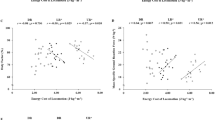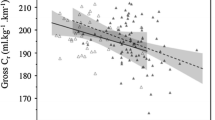Summary
The running economy of seventeen athletes was studied during running at a low speed (3.3 m · s−1) on a motor-driven treadmill. The net energetic cost during running expressed in kJ·kg−1·km−1 was on average 4.06. As expected, a positive relationship was found between the energetic cost and the percentage of fast twitch fibres (r=0.60,n=17,p<0.01). In addition, the mechanical efficiency during two different series of jumps performed with and without prestretch was measured in thirteen subjects. The effect of prestretch on muscle economy was represented by the ratio between the efficiency of muscular work performed during prestretch jumps and the corresponding value calculated in no prestretch conditions. This ratio demonstrated a statistically significant relationship with energy expenditure during running (r=−0.66,n=13,P<0.01), suggesting that the elastic behaviour of leg extensor muscles is similar in running and jumping if the speeds of muscular contraction during eccentric and concentric work are of similar magnitudes.
Similar content being viewed by others
References
Asmussen E (1952) Positive and negative muscular work. Acta Physiol Scand 28:364–382
Asmussen E, Bonde-Petersen F (1974) Storage of elastic energy in skeletal muscle in man. Acta Physiol Scand 91:385–392
Awan MZ, Goldspink G (1972) Energetics of the development and maintenance of isometric tension by mammalian fast and slow muscles. J Mechanochem Cell Motil 1:97–108
Barany M (1967) ATPase activity and myosin correlated with speed of muscle shortening. J Gen Physiol [Suppl 2] 50:197–218
Bates BT, Osterning LR, Mason BR (1978) Lower extremity function during the support phase of running. In: Asmussen E, Jørgensen K (eds) Biomechanics VI-B. University Park Press, Baltimore pp 30–39
Bergström J (1962) Muscle electrolytes in man. Scand J Clin Lab Invest Suppl 68
Bosco C (1982) Stretch-shortening cycle in skeletal muscle function, with special reference to elastic energy and potentiation of myoelectrical activity. Studies in Sport, Physical Education and Health 15. University of Jyväskylä
Bosco C (1985) Mechanical delay and recoil of elastic energy in slow and fast types of human skeletal muscle. Abstract, X International Congress of Biomechanics. Arbete och hälsa 14:35
Bosco C, Rusko H (1983) The effect of prolonged skeletal muscle stretch-shortening cycle on recoil of elastic energy and on energy expenditure. Acta Physiol Scand 119:219–224
Bosco C, Komi PV, Ito A (1981) Prestretch potentiation of human skeletal muscle during ballistic movement. Acta Physiol Scand 111:135–140
Bosco C, Viitasalo JT, Komi PV, Luhtanen P (1982a) Combined effect of elastic energy and myoelectrical potentiation during stretch-shortening cycle. Acta Physiol Scand 114:557–565
Bosco C, Ito A, Komi PV, Luhtanen P, Rahkila P, Rusko H, Viitasalo J (1982b) Neuromuscular function and mechanical efficiency of human leg extensor muscles during jumping exercises. Acta Physiol Scand 114:543–550
Cavagna GA (1977) Storage and utilization of elastic energy in skeletal muscle. In: Hutton RS (ed) Exercise and sport sciences reviews. Journal Publ. Santa Barbara, pp 89–129
Cavagna GA, Citterio G (1974) Effect of stretching on the elastic characteristics and the contractile component of frog striated muscle. J Physiol (Lond) 239:1–14
Cavagna GA, Kaneko M (1977) Mechanical work and efficiency in level walking and running. J Physiol (Lond) 268:467–481
Cavagna GA, Saibene FP, Margaria R (1964) Mechanical work in running. J Appl Physiol 19:249–256
Cavagna GA, Dusma B, Margaria R (1968) Positive work done by a previously stretched muscle. J Appl Physiol 24:21–32
Cavanagh PR, Kram R (1985) The efficiency of human movement — a statement of the problem. Med Sci Sports Exerc 17:304–308
Cavanagh PR, Williams KR (1982) The effect of stride length variation on oxygen uptake during distance running. Med Sci Sports Exerc 14:30–35
Costill DL, Thomason H, Roberts E (1973) Fractional utilization of the aerobic capacity during distance running. Med Sci Sports 5:248–252
Davies CTM, Barnes C (1972) Negative (eccentric) work. Physiological responses to walking uphill and downhill on a motor-driven treadmill. Ergonomics 15:121–131
di Prampero PE, Cortili G, Mognoni P, Saibene FP (1979) Equation of motion of a cyclist. J Appl Physiol 47:201–206
Goldspink G, Larson RE, Davies RE (1970) The immediate energy supply and the cost of maintenance of isometric tension for different muscles in the hamster. Z Vgl Physiol 66:389–397
Gollnick PD, Armstrong RB, Saubert IV CW, Piehl K, Saltin B (1972) Enzyme activity and their composition in skeletal muscle of untrained and trained men. J Appl Physiol 33:312–319
Huxley AF, Simmons RM (1971) Mechanical properties of the cross-bridges of frog striated muscle. J Physiol (Lond) 218:59–60P
Ito A, Komi PV, Sjödin B, Bosco C, Karlsson J (1983) Mechanical efficiency of positive work in running at different speeds. Med Sci Sports Exerc 15:299–308
Kaneko M, Fuchimoto T, Ito A, Toyooka J (1983) Mechanical efficiency of sprinters and distance runners during constant speed running. In: Matsui H, Kobayashi K (eds) Biomechanics VIII-B. Human Kinetics Publishers, Champaign, Ill, pp 754–761
Lännergren A (1976) Force-velocity relation of isolated twitch and slow muscle fibres. XV Scandinavian Congress of Physiology and Pharmacology, Århus. Acta Physiol Scand [Suppl] 404:87
Margaria R (1938) Sulla fisiologia e specialmente il consumo energetico della marcia a della corsa a varia velocita ed inclinazione del terreno. Atti della R Academia Nazionale dei Lincei (Rendiconti) 7:299–368
Margaria R, Aghemo P, Pinera Limas F (1975) A simple relation between performance in running and maximal aerobic power. J Appl Physiol 38:351–352
Padykula R, Herman E (1955) The specificity of the histochemical method of adenosine triphosphatase. J Histochem Cytochem. 3:170–195
Passmore R, Durnin JVGA (1955) Human energy expenditure. Physiol Rev 35:801–836
Wendt IR, Gibbs OL (1974) Energy production of mammalian fast and slow twitch muscle during develoment. Am J Physiol 226:642–647
Author information
Authors and Affiliations
Rights and permissions
About this article
Cite this article
Bosco, C., Montanari, G., Ribacchi, R. et al. Relationship between the efficiency of muscular work during jumping and the energetics of running. Europ. J. Appl. Physiol. 56, 138–143 (1987). https://doi.org/10.1007/BF00640636
Accepted:
Issue Date:
DOI: https://doi.org/10.1007/BF00640636




